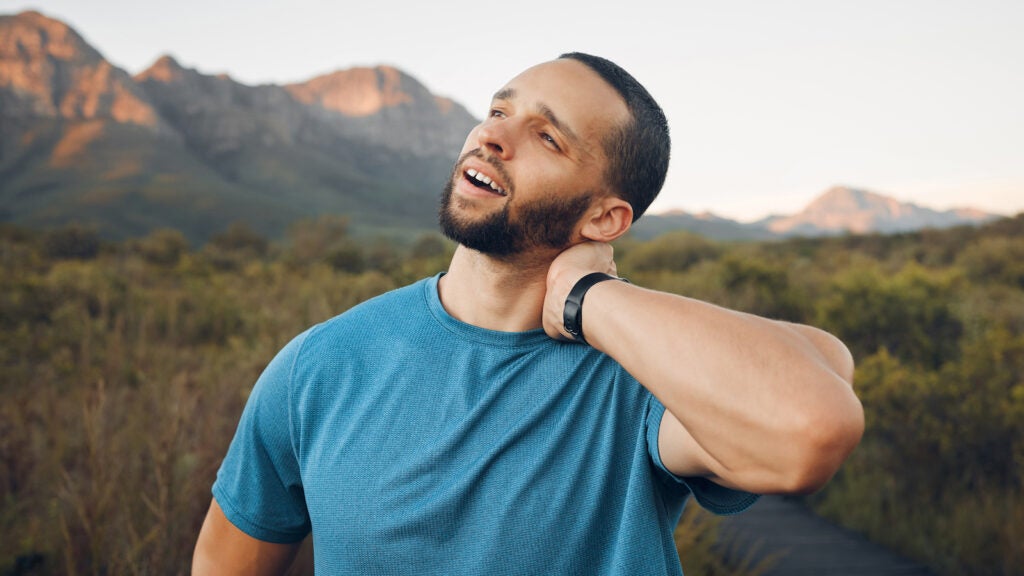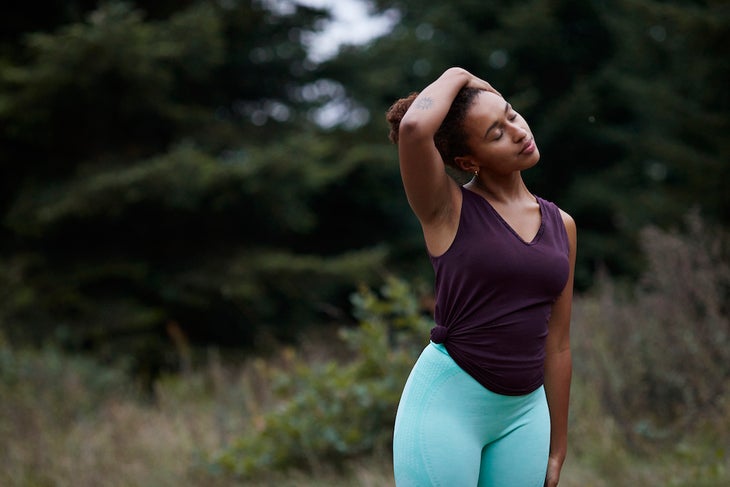



Neck pain on the trail can be a real nuisance. When it strikes, every turn or tilt of the head is a source of discomfort, and your pack feels at least 10 pounds heavier than when you started. Your best bet is to prevent neck pain altogether with good posture, a strong core, and a pack that fits properly. But if you do find your neck muscles getting stiff or knotted by the end of the day, it’s helpful to have a few stretches and mobility drills in your back pocket.
We asked Hilary Granat, P.T., D.P.T., M.S., owner of C.O.R.E. Physical Therapy in Washington, D.C., for the best trail-friendly stretches for backpackers dealing with neck pain. Below are her picks, all of which require no equipment and can be done in less than 15 minutes. Note: If you feel sharp pain or extreme discomfort while doing any of these exercises, stop immediately.
You can increase your range of motion and decrease tension in your neck by doing this quick drill from a seated or standing position (even on the trail during water breaks). When you reach the end of your range of motion for each stretch, hold for three seconds before continuing. Do five reps (one rep equals both directions) of each.
Side to Side: Rotate your head to look to the left and hold. Then, rotate your head to the right and hold.
Ear to Shoulder: Keeping your shoulders rolled back, bend your neck to bring your right ear down toward your right shoulder and hold. Return to a neutral position, then bring your left ear toward your left shoulder and hold.
Up and Down: Draw your chin toward your chest to bring your head forward and hold. Return to a neutral position, then look up at the sky to extend your neck and hold.
Shrugging and rolling the shoulders engages and relaxes the upper trapezius (shoulder muscles), which can alleviate neck pain. “When people have a pack on their shoulders, sometimes that upper trap is not at all engaged because the pack is pulling their shoulders down,” Granat explains. “Doing a couple of shrugs engages that muscle.”
Rolling the shoulders backward also helps relax the shoulder muscles and increase range of motion while counteracting the “hunched” position that so many people develop both on and off the trail. Do 10 reps of each of the following.
Shoulder Shrug: From a seated or standing position, lift both shoulders up toward your ears. Maintain good posture, hold for three seconds, then release.
Shoulder Roll: From a seated or standing position, place your right fingertips on your right shoulder and your left fingertips on your left shoulder. With good posture, slowly roll your shoulders backward, drawing large circles with your elbows.
Chin tucks lengthen and strengthen the muscles in the back of the neck, known as the deep neck flexors, which stabilize the neck. You can do this exercise from a sitting or standing position, or when lying flat on your sleeping pad at the end of the day.
Start with excellent posture. “Think about elongating your spine, or pretend there’s a book on your head or your chin is on a shelf,” Granat suggests. Place a finger on your chin. Holding your finger still, use your neck muscles to draw your chin back toward your throat, as if to give yourself a double chin. (Don’t press with your finger, but use it as a target when moving back and forth—the movement should come only from your neck.) Hold for three seconds, then release and repeat for 10 reps.

“When you’re carrying a backpack, your shoulders are forward, your chest is usually a little caved in,” Granat says. “By putting your hands behind your back and sticking your chest out, you’re counteracting all of that forward head, forward shoulder posture.”
Clasp your hands behind your back. Roll your shoulders backward and straighten your arms. “Think about lengthening your collarbones so you’re opening up your chest,” Granat says. To deepen the stretch, lift your arms. Hold for 20 to 30 seconds and repeat for three reps.
This stretch targets the upper trapezius, which runs all the way from the upper back of your shoulders up to the base of your skull. If you’re doing it right, you’ll feel a deep stretch on the side of your neck and the top of your shoulder.
Stand with your shoulders rolled back and your chest open. Place both hands behind your back and grab your right wrist with your left hand. Pull down on your right arm and tilt your head to the left. Hold for 20 to 30 seconds, then switch sides and repeat for two to three reps per side.
Granat says that the levator scapulae stretch, which focuses on the muscles in the neck and upper back that pull up on the shoulder blades, is a favorite among her clients.
Stand with your shoulders rolled back and your chest open. Reach your right arm up and over your head and place your right palm on the left side of your head above your ear. Gently pull your head toward your right shoulder. Once your neck is in a side bend, rotate your head so that you’re looking at your right armpit. Be careful not to rush through the steps; settle into the side bend of the neck before rotating your head. Hold for 20 to 30 seconds, then switch sides and repeat for two to three reps per side.
From 2023

